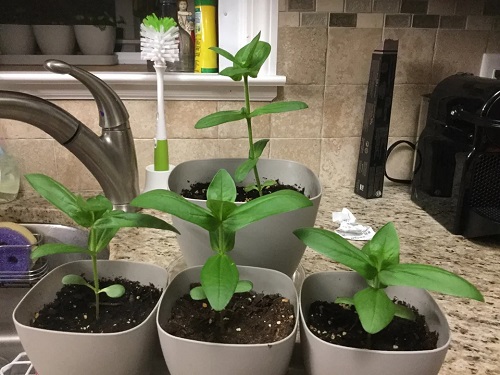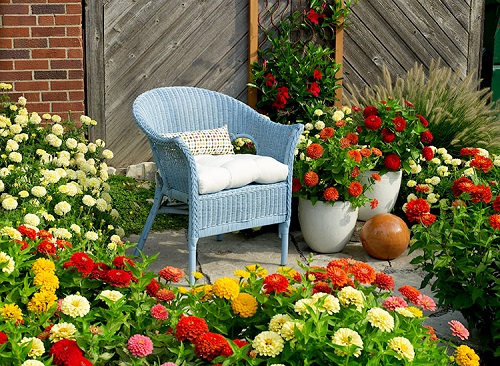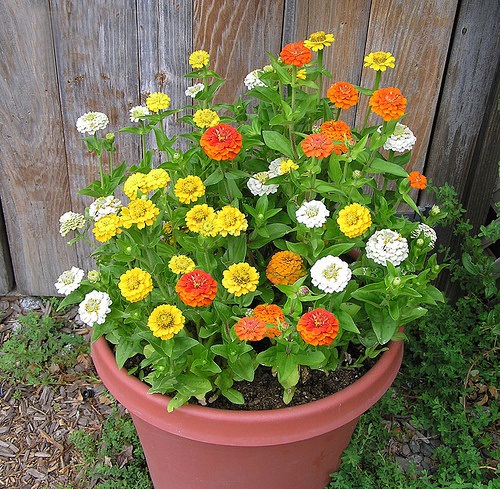Here is all about Growing Zinnias in Pots that will help you grow these beauties easily in a small space like a patio or balcony!
Zinnia plants are colorful, annual flowering plants that are easy to grow and care for. Growing Zinnias in Pots can be a great way to add color and beauty to your balcony and other small corners of the house.
Zinnia Plant Profile
Zinnia plants are colorful annual flowers that come in a wide variety of colors, including red, pink, yellow, orange, and purple, and can grow up to 2-4 feet tall. They are a popular choice for gardeners, as these flowers attract pollinators such as butterflies and bees. The plants are also great for cutting and using in floral arrangements.
Zinnias prefer full sun and well-draining soil and should be watered regularly. With proper care, zinnias can bloom throughout the summer and into the fall, providing a beautiful burst of color to any garden or indoors.
Fact: It is one of the longest-lasting flowers in the world!
Here are the most Charming Flowers that Don’t Fade Before a Month
Propagating Zinnia Plant

For Growing Zinnias in Pots, you can propagate them using seed and stem cuttings. The best time to propagate zinnias is in early spring when the nights are still cool but the days are becoming warmer.
From Seeds:
- Collect mature zinnia flower heads and remove the seeds.
- Sow the seeds in a well-draining, fertile potting mix.
- Water the soil regularly to keep it moist but not waterlogged.
- Keep the soil temperature between 70-75°F (21-24°C) for optimal germination.
- Zinnia seeds typically germinate within 5-10 days.
- Once the seedlings have grown a few inches tall, thin them out and move them to separate pots.
From Stem Cuttings:
- Take 4-6 inches of cutting from a healthy zinnia plant using clean scissors.
- Remove the lower leaves from the cutting, leaving only a few leaves at the top.
- Dip the cut end of the stem in the rooting hormone.
- Plant the cutting in a well-draining, fertile soil mix.
- Keep the soil moist and place the cutting in a warm, bright area with indirect sunlight.
- Zinnia stems cuttings usually root within 2-3 weeks.
- Once the cutting has rooted, transplant it into a larger pot and care for them like you would a Zinnia plant.
Best Pot Size for Growing Zinnias
For Growing Zinnias in Pots, consider the size of the plant and its root system. Generally, a pot with a diameter of 8-12 inches and a depth of 8-10 inches is suitable for a single Zinnia plant.
As the plant continues to grow, you can keep on re-potting it in a one-size bigger container than the old one.
Requirements for Growing Zinnias in Pots
Sunlight
These beautiful plants love some full sun to thrive and need at least 6-7 hours of direct sunlight each day. Remember, the more sun they get, the better.
Zinnias can tolerate some light shade, but too much shade will lead to leggy growth and reduced flowering.
Soil
Zinnias thrive in well-draining soil that is rich in organic matter. A soil pH between 5.5 and 7.5 is ideal. These plants can tolerate a range of soil types, including sandy or clay soils, as long as the soil is not compacted and provides good drainage.
A good mix consists of one part compost, one part topsoil, and one part sand or perlite.
Water
Zinnias require regular watering, but it is important not to overwater them as the same can cause various issues to the plant.
The soil should be kept evenly moist but not waterlogged, as this can cause root rot.
Watering once or twice a week, depending on the climate and soil moisture level, is generally sufficient. The best is to water the plant only when the topsoil feels a little dry to the touch.
Temperature and Humidity
Zinnias prefer warm temperatures between 70°F and 85°F (21°C to 29°C Celsius). Frost or freezing temperatures can damage or kill Zinnia plants.
They would do just fine in regular humidity. Too much humidity around the plants can attract fungal issues.
Growing Zinnias in Pots – Care
Fertilizing
Zinnia plants benefit from regular fertilization as it supports their growth and flowering. Go for a 10-10-10 or 5-10-5 liquid blend. Dilute it to 1/2 of its strength and use it every 3-4 weeks.
Make sure to water the plant thoroughly after application to help the nutrients get absorbed into the soil. Additionally, adding compost or other organic matter to the soil will help the plant to absorb additional nutrients.
Pests and Diseases
Zinnia plants can be affected by several pests, including aphids, spider mites, thrips, and whiteflies. Insecticidal soap or neem oil can be used to control minor infestations.
Regularly inspecting plants for signs of pest activity and addressing issues promptly can help prevent widespread damage.
These plants can also be susceptible to various diseases, including powdery mildew, bacterial leaf spot, and gray mold.
Snip away dead leaves, flowers, and parts of the plants from time to time. Also, avoid overhead watering to prevent disease outbreaks. Selecting disease-resistant cultivars and maintaining good air circulation can also help prevent disease issues.





